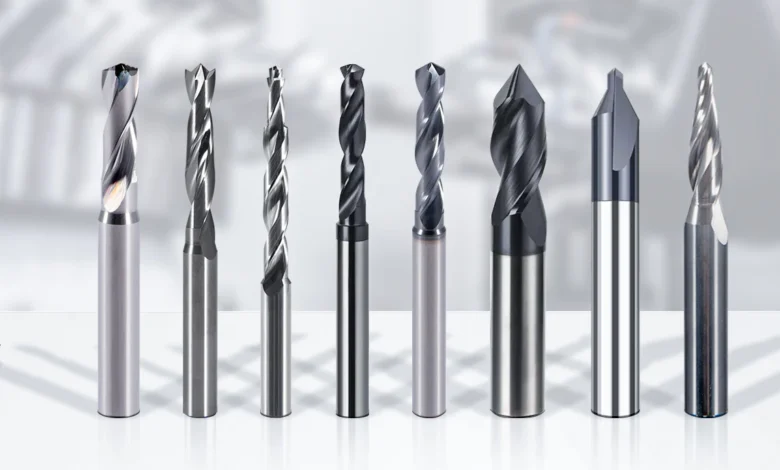How to choose carbide end mills to improve efficiency?

Choosing a good cutting tools manufacturer is crucial in manufacturing. A good supplier can provide consistent quality and comprehensive service.
Today, we’ll explore how to choose the right milling cutter to improve efficiency from a manufacturer’s perspective.
Getting to Know Milling Cutters
In modern manufacturing, whether it be automotive parts, precision molds, or electronic product casings, many complex metal parts require milling to be formed.
The key tool for milling is a carbide milling cutter.It is equivalent to a “carving knife” in a machining center, cutting metal materials through high-speed rotation.
However, faced with increasingly hard materials such as stainless steel, quenched steel, and titanium alloys, as well as higher requirements for processing efficiency and precision,traditional high-speed steel milling cutters suffer from rapid wear, low efficiency, and inability to meet high processing requirements.
At this point, carbide milling cutters stand out for their outstanding performance, becoming the mainstream choice for modern high-efficiency machining.
What is carbide?
Carbide, also known as tungsten-cobalt cemented carbide, is a composite material with high hardness and wear resistance, mainly composed of tungsten carbide (WC) metal carbide particles, which are sintered at high temperature and pressure using a metal binder mainly composed of cobalt (Co).
It has extremely high hardness. Its hardness is much higher than that of high-speed steel and second only to diamond, enabling it to effectively cut various hard materials.
And it also has excellent wear resistance. This means that during the machining process, the cutting edge of the tool has high wear resistance and can remain sharp for a long time, thereby producing parts with more stable dimensions and smoother surfaces.
Excellent heat resistance (red hardness). Even under high-speed cutting in high-temperature environments of 800-1000°C, cemented carbide can maintain high hardness and strength, is not easily softened or deformed, and ensures the stability and reliability of the machining process.
It has a high compressive strength. Although cemented carbide is brittle and not as impact resistant as high-speed steel, it has very strong compressive strength and is very suitable for withstanding cutting pressure.
It is precisely these outstanding material properties that have established cemented carbide as the core material for today’s high-efficiency cutting tools.
How to choose carbide milling cutters
Although carbide milling cutters have superior performance compared to traditional high-speed steel milling cutters, not all carbide milling cutters can be used to machine any workpiece.
We need to choose a suitable carbide milling cutter in order to significantly improve efficiency, ensure quality, and reduce costs.Conversely, improper selection may result in accelerated tool wear, poorer machining results, and even damage to workpieces and equipment.I will list the common carbide milling cutters available on the market:
Flat End Mills
Their distinctive feature is the sharp 90° right angle formed at the end of the cutting edge.
This design is intended for machining flat surfaces and cavities with clear, sharp internal angles.
They are commonly used tools for general milling operations, including slotting, machining pockets with sharp internal angles, and contouring operations requiring precise, rounded-edge-free profiles.
Ball End Mills
Their distinctive feature is their spherical cutting end. This unique geometry makes them particularly suitable for creating arc contours and complex surfaces.
Bull-Nose End Mills
Their distinctive feature is a precisely defined arc radius at the junction between the peripheral cutting edge and the end face, which effectively eliminates sharp 90° right angles.
T-type Milling Cutters
They are characterized as specialized tools designed specifically for milling T-shaped grooves and side grooves in workpieces.
So, faced with the wide variety of carbide milling cutters available on the market, how can we make a wise choice to ensure that they become truly effective tools for efficient production?
Common Materials and Corresponding Milling Cutter Selection
The material of the workpiece is the primary factor in selecting a cutting tool. Different materials have huge differences in hardness, toughness, and stickiness.
Stainless steel and cast iron are the most common processing materials with a wide range of choices. For these materials, we focus on the versatility and cost-effectiveness of cutting tools.
The characteristics of stainless steel materials are that they tend to “stick to the cutter” and harden easily during processing.For this type of material, we need to choose a sharp cutting edge and a large helix angle design to improve chip removal and reduce material adhesion to the tool. We also need to select a better grade of milling cutter or coating to resist work hardening.
Aluminum alloys and other non-ferrous metals are relatively soft and easy to cut, but they also tend to stick to the cutting tool. We should prioritize milling cutters with sharp edges, large front angles, large helix angles, polished edges, or mirror coatings to ensure surface finish and prevent built-up edges.
High-temperature alloys and titanium alloys are difficult to machine. It is necessary to select high-toughness grades and high-temperature-resistant coatings, and strictly control cutting parameters.
Clearly defining the purpose of machining is key to selecting the right cutting tool.
Classification of carbide milling cutter processing
Rough machining aims to quickly remove a large amount of material, so we need to choose tools with high strength and large chip pockets. In terms of coating, we focus on coatings with good wear resistance.
Finishing aims to achieve high precision and smoothness, so we need to choose tools with sharp cutting edges and high runout accuracy, while coatings should be selected for their heat resistance and smoothness.
Different machining features, such as deep grooving, milling cavities, and machining thin-walled parts, require the selection of specific tools and geometric angles.
Summarize
In summary, to select the right carbide milling cutter, it is necessary to consider the material being machined, the machining task, and the cutter itself.The right choice can result in longer tool life, higher machining efficiency, better workpiece quality, and the lowest overall production costs.


